When disaster strikes stores shelves empty fast and you can only stockpile so much in preparation. So if you want to survive long term then these are the top ten vegetables with the highest calorie count that will grow in most places in the US
In hard times you need to be sure you are planting vegetables with the highest calorie count to keep your family well-fed.
They will go a long way in contrast to the low-quality wheat, grains, and nuts you can find in the grocery store.
For example chickpeas have a calorific value of 1651 per pound whereas to get the same amount of calories you would have to chomp through over 25 pounds of iceberg lettuce at 64 calories per pound!
On top of that, vegetables are a good source of essential vitamins such as folate, manganese, and phosphorus for our bodies to use.
Stock up on seeds now and get your survival garden growing as you never know when a SHTF situation will occur.
Plus, you’ll benefit from healthy food and be a pro at planting when you really need to survive off your garden.
All percentages of Recommended Daily Allowance (RDA) quoted are worked on a 2000-calorie per day diet and will obviously vary should your calorie intake be higher or lower.
Factors That Affect The Caloric Intake From Vegetables
Alongside the nutrient content found within the vegetables, the amount of energy they will give you is subject to factors both within and out of your control.
High-calorie foods are usually found with a good source of protein which is important for maintaining muscle mass, controlled weight gain or losses, and a healthy weight.
What Type Of Vegetable Really Matters
Leafy greens such as lettuce provide water and not much else. The caloric value is negligible and would require a large amount to be consumed in order to have any substantial impact on your health.
Root veggies are amongst the best foods for calories. In fact, starchy vegetables in general provide more calories than any other.
This is because of the fact that they store a lot of their energy inside their “bulbs” which is meant for release in the spring when the plant starts to grow.
The Cooking Method Is Important Too
Amongst other vegetables, potatoes require cooking before they are edible. This applies for a lot of the root varieties that you might have in your garden.
Cooking your veggies has the potential for adding calories since you might be drying them in oil or butter; However, it also destroys some of the nutrition that can be found within the plant.
For things that you can eat raw it is best to consume it and it’s natural form unless you are using it in a recipe.
The 10 Highest Calorie Vegetables
If you’re interested in starting your own vegetable garden, have a look below at the list of the 10 highest calorie vegetables you can grow. Remember to get organic seeds that are high quality to ensure that you maximize the gains from these amazing plants.

1. Corn
Calories per pound: 1657
Corn, a staple of the Native Americans, and for millions across Africa and South America, provides what you need to survive: 21% of a 100g serving is made up of carbs and 3.4 % of protein, with 2.4% fiber and 4.5 % sugar, and it has 1.5% fat.
What soil does corn need?
Corn needs a neutral soil with a pH of around 6.5 Soil should drain well but be loamy as the roots are shallow and will dry out quickly if not kept moist during the growing period.
When to plant
The soil temperature should have reached 60 degrees Fahrenheit before planting and seed should be planted directly in the ground around two weeks after the last frost of the season.
Try to plant at two-week intervals so you’ll be obtaining fresh corn for a long as possible. Your aim should be to harvest all corn before the first winter frosts occur.
How to plant
Corn is wind pollinated so plant in a square for effective pollination. The seed should be planted 1 ½ to 2 inches deep, 4 to 6 inches apart and in rows between 30 to 36 inches from each other.
How many should I plant?
Grow 80 plants to feed a family of four. This allows for extra to store over the winter.
Yield
If you are lucky you will get two ears of corn per plant, usually only one.

2. Chickpeas
Calories per pound: 1651
Neither actual pea nor bean, chickpeas (cicer arietinum) are worth cultivating despite their rather long growing period of 100 or so days.
They provide 68% of the RDA of dietary fiber in a 3.52-ounce (100g) serving, 38% protein, and are rich in iron – 34%, vitamin B6 -25% and magnesium 28%.
Chickpeas are wonderful for adding to casserole and stews or as extenders to salads. Greek hummus, a dip made from chickpeas, garlic, olive oil, and tahini paste is delicious.
They are a wonderful example of calorie-dense foods.
Most kids won’t object to chickpeas blended into soups, stews, or vegetarian burger patties and some even enjoy them freshly boiled, straight from a bowl sprinkled with salt, something like popcorn.
What soil do they need?
Moist, well-drained soil suits them best. Like other legumes, chickpeas work with microorganisms in the soil to get the nitrogen compounds they need for successful growth, so do not add nitrogen fertilizers to the soil.
When to plant
They need to be planted after the last frost in spring. It’s preferable to get a head start by growing the seedlings indoors in peat pots or paper ones and then planting them out when the danger of frost is past, pot and all, so the roots aren’t disturbed.
How to plant
Plant between 1 ½ to 2 inches deep around 6 inches from each other and in rows about 18 inches apart. They grow from 10 to 22 inches high.
How many should I plant?
If you are growing for family use you will need around 12 plants for a family of four, to provide fresh chickpeas that can be eaten straight from the pod, or dried out and stored – they last for up to a year if well dried out.
The pods will bear one or two seeds and the plant will continue flowering and producing pods as long as conditions are right.
Yield
If picked when green expect ½ to 1-½ pounds per plant. If you allow the chickpeas to dry on the plant naturally you’ll be harvesting ¼ to ½ pound per plant if you are lucky.
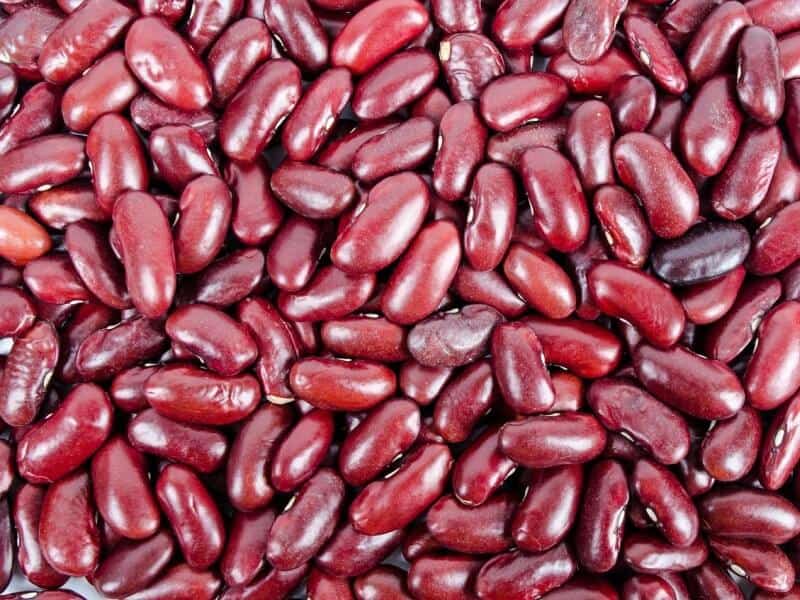
3. Kidney/ Lima beans
Calories per pound: 1520
Growing your own kidney beans is a great way to supplement your stocks.
You can try them in a really sheltered position or in a glass house in cooler zones. A 3.52-ounce (100g) serving of kidney beans will contain 48% of your RDA of protein, making them an alternative to animal protein.
They provide 100% of the RDA of dietary fiber, and are rich in iron – 45%, vitamin B6 -20% and magnesium 35%.
What soil do they need?
Like other legumes, beans like a well-drained soil, and work with microorganisms in the soil to get the nitrogen compounds they need, so do not add nitrogen fertilizers to the soil, otherwise you will get lots of leafy growth and no beans!
When to plant
They need to be planted after the last frost in spring in a position that gets full sun. The soil temperature for them to germinate successfully is 65 degrees Fahrenheit.
They must be planted where they are to grow, as they don’t take to being transplanted. Decide on whether you are planting bush or vining types as the vining types will need a sturdy trellis to support their growth.
How to plant
You can soak kidney/lima bean seeds in lukewarm water for up to 4 hours before planting to encourage quicker germination, or you can simply plant them without soaking.
Plant between 1 to 1 ½ inches deep, 4 inches from each other for the vining type and 8 inches or so for the bush types. Rows should be about 30 inches apart, and the young plants should emerge 10 to 18 days after planting.
How many should I plant?
For a family of four, allow for 30 plants.
Yield
You can expect around 100 beans per plant. When the pods start going yellow leave them to dry out on the plant before harvesting.
If you are in a humid area and rain is likely at this time then rather pull out the whole plant once it is a straw color, bean pods and all, then tie the plants upside down in a dry sheltered spot with plenty of air circulation between the plants to allow them to finish drying out completely.
Pinto beans and black beans are other varieties that you can grow if you want to keep a versatile stock in your pantry or dry storage.
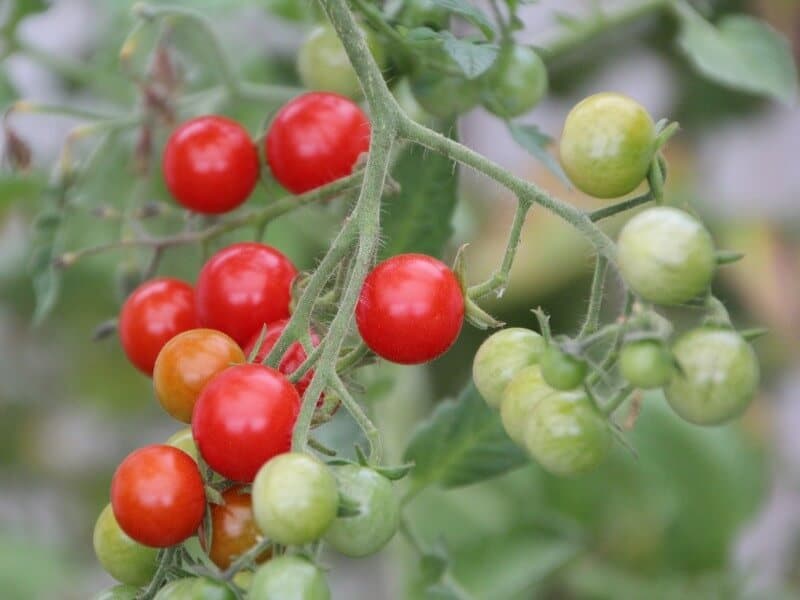
4. Cherry Tomatoes
Calories per pound: 454
The cowboys used to carry tomatoes with them to eat for the water content, but they also contain fiber and sugar and loads of healthy vitamins, forming an integral part of summer salads, pizza, and pasta bases.
What soil do tomatoes need?
Tomatoes need a well-drained composted loam and they may need weekly fertilizing for peak production.
When to plant
Transfer seedlings to their outdoor position after all danger of frost is past, on a cloudy day and water well so they don’t wilt.
They will start to flower around 30 days after germinating and will continue to produce tomatoes for the whole season. Germination will occur when the soil temperature is around 70 to 90 degrees Fahrenheit.
How to plant
Plant seed from fresh cherry tomatoes ¼ inch deep in containers or compostable peat pots, or use seed from your seed merchant.
They need 8 hours of sun per day and can also be grown in containers. Most types will need a frame they can climb on to support the plant if in a container, or if outside they can be staked.
How many should I plant?
Plant 16 bushes for a family of four so you have plenty for salads all through the summer and can freeze some for stews and casseroles in winter.
Yield
Expect around 100 or more little cherry tomatoes from each plant. Some varieties like the Roma will give more.
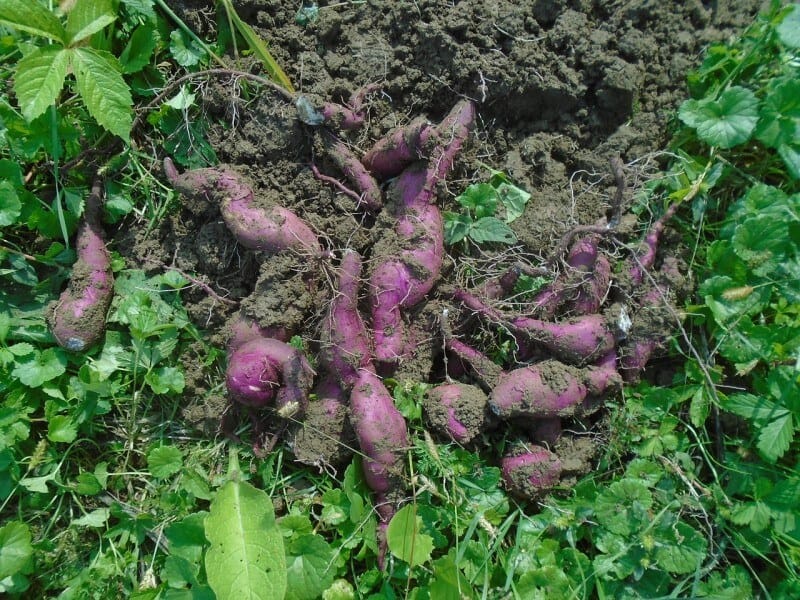
5. Sweet Potatoes
Calories per pound: 390
With an 89% carbohydrate content and 8% protein these tasty vegetables will keep you full – especially roasted in olive oil with some rosemary and garlic and a sprinkle of Himalayan salt.
What soil do sweet potatoes need?
A well-drained sandy loam allows the tubers to With 51% protein, 11% fat and 38% carbs in a 100g serving, expand underground. If you plant in clay soil the roots will be misshapen as they struggle against the stiff soil.
When to plant
Plant in full sun after all danger of frost is past – in fact 3 to 4 weeks afterwards when the soil temperature is around 60 degrees Fahrenheit.
Because they have a long growing period of 90 to 170 days it is advisable to start your sweet potato runners early in the season indoors in jars. The other option in warmer areas is to plant tubers straight into the ground.
How to plant
Plant in holes 6 inches deep 12 inches apart if you are planting tubers. If planting slips make sure to bury all the roots right up to where the first set of leaves appears.
Tamp the soil gently and water thoroughly to get them started. Leave enough room between rows – 24 inches so that the runners can set down roots –giving you more tubers.
How many should I plant?
Plant 20 sweet potato plants for a family of four.
Yield
In warmer areas expect around 8 sweet potatoes per plant. Harvest when the tips and leaves start to turn yellowish. They can also be left in the ground to continue growing until just before the first fall frost.
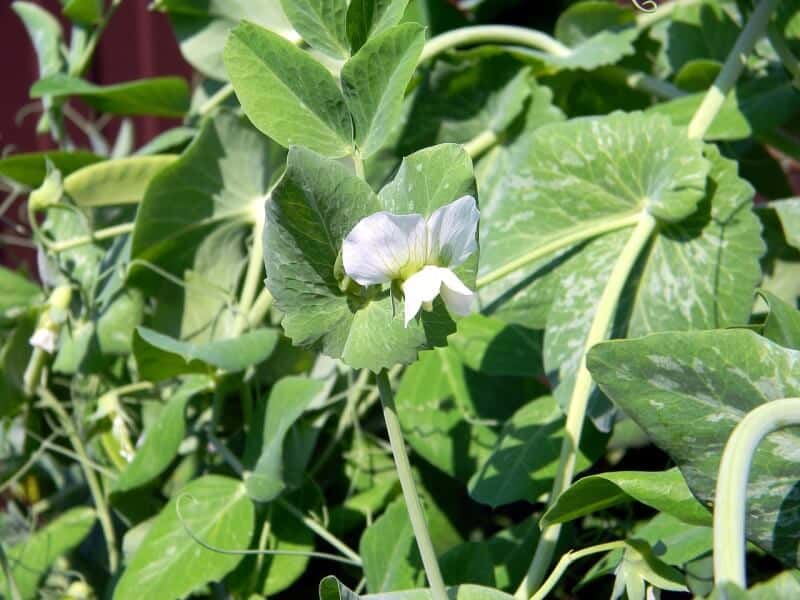
6. Peas
Calories per pound: 368
With 51% protein, 11% fat and 38% carbs in a 100g helping, peas are healthy, filling, and good for blood sugar levels.
What soil do peas need?
Peas need a rich well-drained soil that was treated with compost the year before Like all legumes, they are nitrogen fixers so do not add nitrogen to the soil.
When to plant
Plant after the last frost. They are a cool season crop so get them in as soon as possible.
How to plant
Dig trenches around ½ inches deep and plant the peas 1 inch deep spaced 6 to 8 inches apart in rows 24 inches apart. Give them some staking so they can climb. Sew new peas every two weeks so you have a continuous supply of fresh green peas and snap peas or mangetout.
How many should I plant?
Around 25 plants per family member should give you enough for the season with a few frozen to add to winter casseroles.
Yield
Depending on how well your peas grow you should get around 50 – 80 individual peas per plant – that is why you need so many plants!
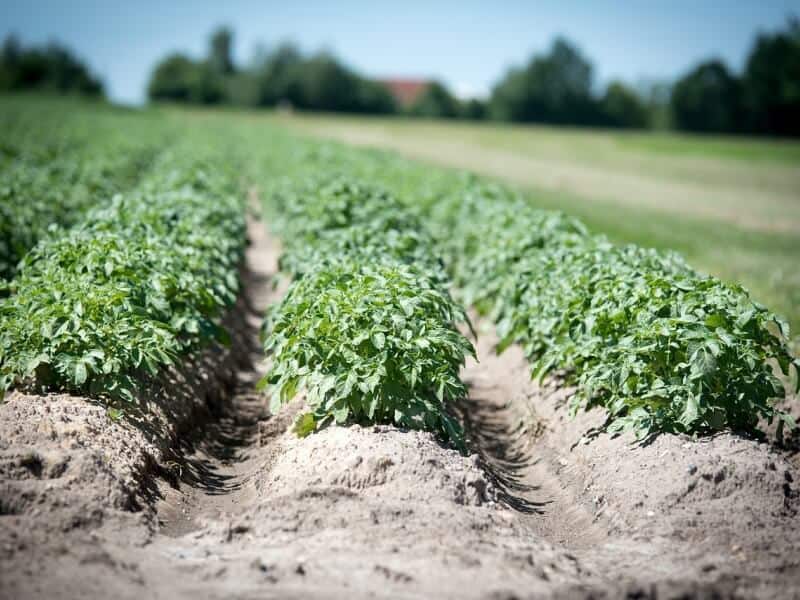
7. Potatoes
Calories per pound: 349-358 (depending on variety)
There would probably be a riot in the household if there were no potatoes as there is so much you can do with them from fries, to mash, potato pancakes, baked potato, rosti, and lots more.
They provide 8% of the recommended daily allowance (RDA) of dietary fiber in a 3.52-ounce (100g) serving, 5% protein, and are rich in Vitamin C – 32%, vitamin B6 -15% and potassium – 12%.
What soil do they need?
Potatoes like loose well-drained, composted soil giving them plenty of room for expansion underground. They like an acidic soil – so if you do a test and the pH is higher than 5.2 your soil is too alkaline and the potatoes will not do well.
When to plant
They like cooler weather so in the warmer states plant as a winter crop. In colder states plant potatoes after the danger of frost is past in the spring.
How to plant
Plant seed potatoes 2 inches deep around 12 inches from each other and in rows 3 feet apart, in an 8 inch deep trench that is about 6 inches wide and tapers to around 3 inches at the bottom.
The reason for planting in a trench is to allow for ‘hilling’ which means gathering up soil around the plant as it grows.
Once they start sprouting, gather up the soil around them, leaving the shoot exposed and repeat until they start blooming. This ensures the tubers stay cool – if they are exposed to the sun they go green.
How many should I plant?
If you are growing for family use you will need around 20 plants to provide fresh potatoes for the family. They are particularly popular with children and you will use a lot more potatoes than other vegetables.
Some people plant their potatoes in old car tires, adding soil and a tire as the plant grows, and eventually may get a whole pocket of potatoes from one plant.
Yield
On average you can expect around 3 to 5 pounds of potatoes from each plant, but if using the car tire method you may increase the yield.
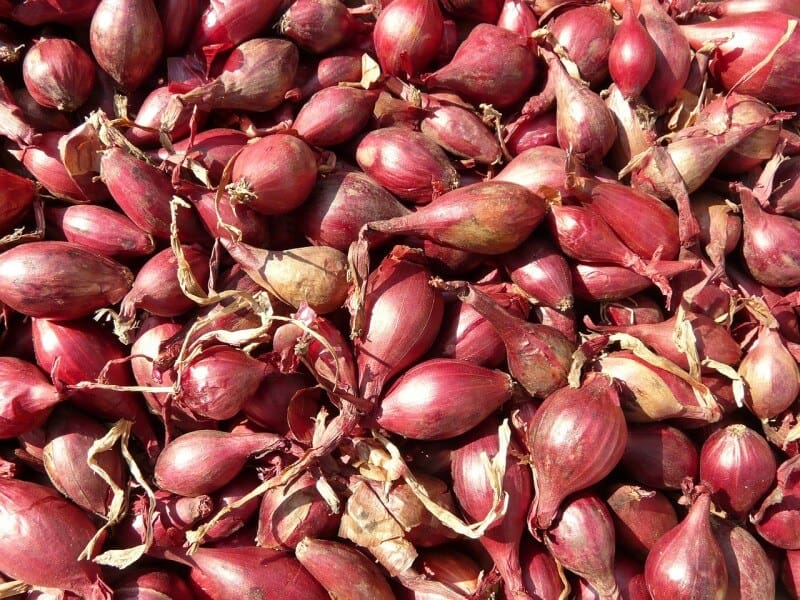
8. Shallots
Calories per pound: 327
While high in calories these cuties also supply 12% of the RDA of dietary fiber per 100g serving, as well as 13% of Vitamin C and 15% of Vitamin B-6 RDA.
What soil do shallots need?
Like most vegetables they prefer a loose well-drained loam that was well composted the year before. They prefer a pH of around 5 to 6.8.
When to plant
They are a cool weather crop but will only start germinating when the soil temperature is around 35 to 50 degrees Fahrenheit.
How to plant
You can plant from seed or from sets – that is the individual cloves picked off from a clump of shallots. Plant 6 to 8 inches apart in rows 12 inches apart and around ½ inch deep in full sun. They are good companion plants for beetroot, tomato and carrots, helping to keep pests at bay.
How many should I plant?
Plant 24 for a family of four. They can be used in soups stews and quiches and the young outer shoots can be cut and chopped like chives to add flavor to salads, omelets and other savory dishes.
Just remember to chop the outer leaves, not the two most inner ones where the shallot is growing, otherwise you will damage your yield.
Yield
Unlike your ordinary onion, these plump purplish alliums with a garlicky flavor produce 4 to 12 usable shallots per plant you put in at the beginning of the season.
They grow about 8 inches tall and are ready for harvest between 60 to 120 days after planting.

9. Carrots
Calories per pound: 186
These vegetables supply carbs, sugar and fiber as well as various vitamins and minerals in a 100g serving.
What soil do carrots need?
Well-drained loose soil that has been doubly dug and given compost and manure will give carrots the chance to grow straight down.
When to plant
They are a cool weather crop so you can get the seed in around 3 weeks before the last frost is expected. They take 70 to 80 days to mature.
How to plant
Plant in rows with about 4 seeds every inch and cover with ¼ to ½ an inch of a compost and sand mix. They will take between 7 to 21 days to germinate depending on the warmth of the soil. Plant in rows 8 inches apart.
How many should I plant?
Plant 80 -100 carrots for the season, staggering planting times so you always have some fresh to pull.
Remember carrot cake is a popular dessert so you’ll need to have some over for baking!
Yield
Plant 80 – 100 carrots for a family of four. Extras can be preserved or frozen for adding to winter dishes. In the spring and summer you’ll want them grated and fresh in your salads.
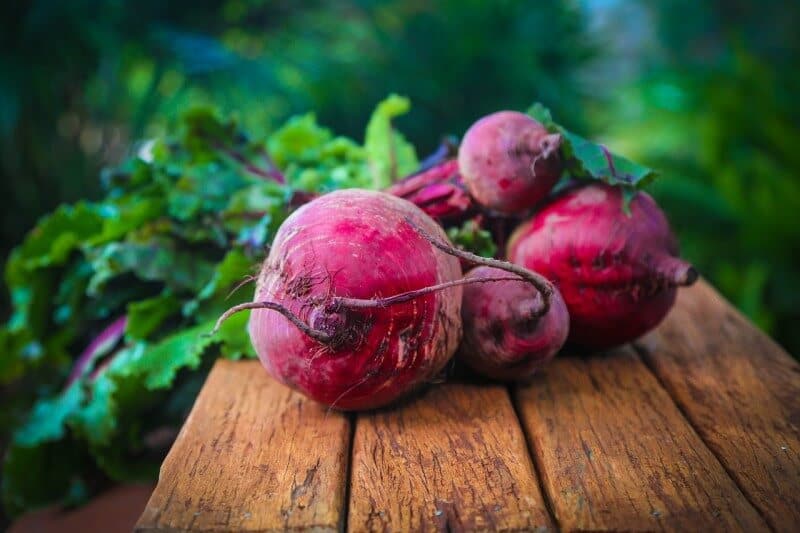
10. Beetroot
Calories per pound: 186
Forget boiled beetroot or beet preserved in vinegar – chefs these days roast their beet with garlic and olive oil, sprinkled with some coarse sea salt for a really tasty treat.
Beetroot has a significant amount of potassium, magnesium, vitamin C and vitamin B 6 as well as 11% of the RDA of dietary fiber in a 100g serving.
What soil do beetroot plants need?
They need a loose well-drained soil to allow those beets to grow big, with a pH of 6.5 to 7.5. The soil temperature should be at least 40 degrees Fahrenheit.
When to plant
Wait until the weather warms up nicely then put them in. Stagger your planting times so you always have tender fresh beets. They like full sun.
How to plant
Soaking the seed in lukewarm water for around 30 minutes before planting will help speed up germination. When planting, dig a groove along the row about 1 inch deep and place your beet seeds 4 inches apart, with the rows 12 inches apart.
Each seed you plant is really a little cluster of seeds and you will get 2 to 4 plants from each seed.
If you want an early start you can plant in seed trays, at a depth of ½ inch. Within 7 to 14 days the plants will have germinated.
You can then plant them outdoors 2 to 3 weeks after germination when they have their second set of leaves.
How many should I plant?
Sow about 60 beets for a family of four so you can enjoy fresh beet and preserve some for winter use.
Yield
One beet per plant.
Ready For Some Gardening?
There are many other vegetables that could be added to this list including butternut squash, pumpkin, and artichoke but this should give you a great starter list that’ll get you going in the short term.
Did we miss any high-calorie plants? Let us know in the comments below, and don’t forget to pin this to your favorite Pinterest board for later.
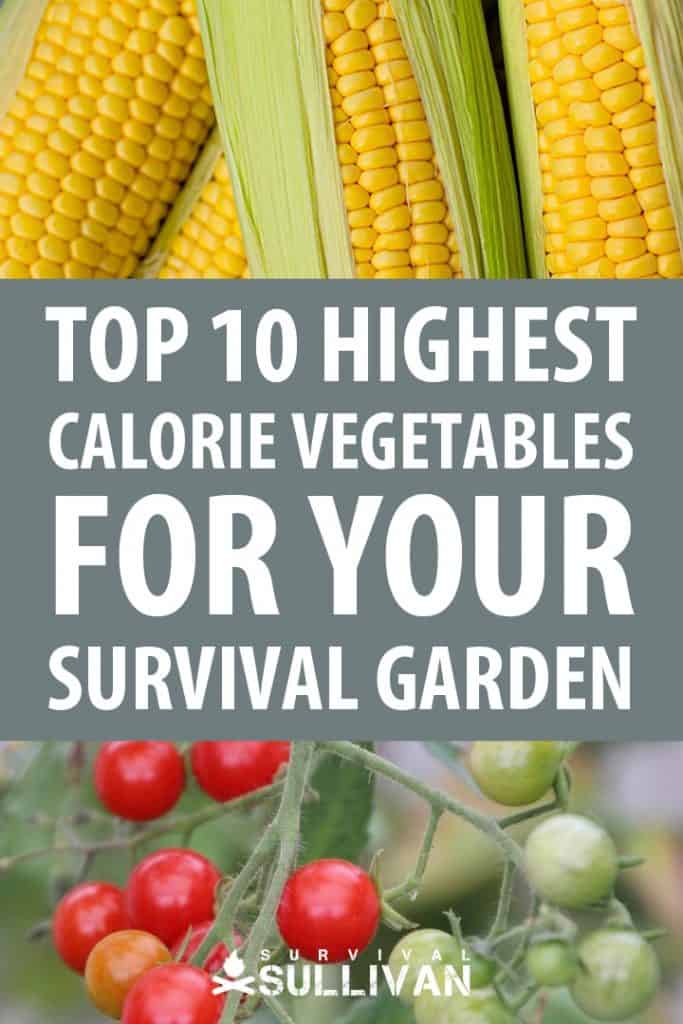

Traveler, photographer, writer. I’m eternally curious, in love with the natural world. How people can survive in harmony with nature has fueled my food safety and survival gardening practices.
At the age of 12, I found a newspaper advertisement for a 155-acre farm at a really good price and showed my parents one Sunday morning. They bought it and I happily started planting vegetables, peanuts, maize and keeping bees with the help of the local labor.
Once I married wherever we moved it was all about planting food, keeping chickens and ducks, permaculture and creating micro-climates. I learned how to build wooden cabins and outdoor furniture from pallets, and baked and cooked home-grown produce, developing recipes as I went along.

Great article. I was shocked that potatoes were so far down the list as I’d always assumed their calorie count was much higher. That’ll teach me to assume. I’m also somewhat surprised that pumpkin or other squash plants didn’t make the top ten.
Potatoes provide the most calories per area of anything and much easier to deal with than corn. Generally corn is subject much more to loss due to deer and raccoons. Feral hogs can annihilate a corn field in short order. To store corn it has to be dried out which if done on the stalk makes it more vulnerable to animals. Corn has to have a good amount of sunshine which is why it is difficult to grow in Ireland and why Irish whiskey is made from barley.
feral hogs provide a goodly amount of calories
The relevant figure is how many calories of food can be produced in a fixed amount of space (such as per square yard), NOT calories per pound of produce. Different vegetables are planted with vastly different spacing between plants, and have vastly different number and sizes of edible portions. Corn, which you list first, is not even close to being in the top ten. Anyone who has planted corn knows that you need a lot of space to get enough to make any difference on your dining room table. You generally get only a single ear, which is not even enough calories for a complete meal, out of a few square feet of garden space.
The article is a valiant attempt, but misses the mark.
An excellent reference on this subject is “Grow or Die The Good Guide to Survival Gardening” by David the Good.
Bill,
There were no claims or promises in this article similar to what you suggested. Some people have enough space to cultivate corn, others do on. Suburban and urban prepper won’t find much value in this article, but your idea is good, I may ask Jeanie to write another top 10 as per your suggestion.
SO, What are YOUR recommendations for highest calorie Veges.
Both criteria are valid
The criterion of the article is great if we think about buying and storing, more calorie per unit is better to stock, it requires less space.
The vision of BillH is better for those who will produce and has little space.
Here in Brazil, growing maize is extremely easier than producing potato, which requires several fungicide applications. We have to adapt what is best for each situation.
Excuse me for mistakes. English is not the mother tongue.
Thanks for the text.
Agreed, the article makes more sense when we think about stockpiling than of cultivation and size of land.
This is my case. I have no agricultural land.
Currently the option is to stock up.
Great article and planting guide. I live in the mojave desert, will any of these do well in the sand? What specific soil would need to be purchased? Lots of sun here, lots of heat too 100-120 during the summer.